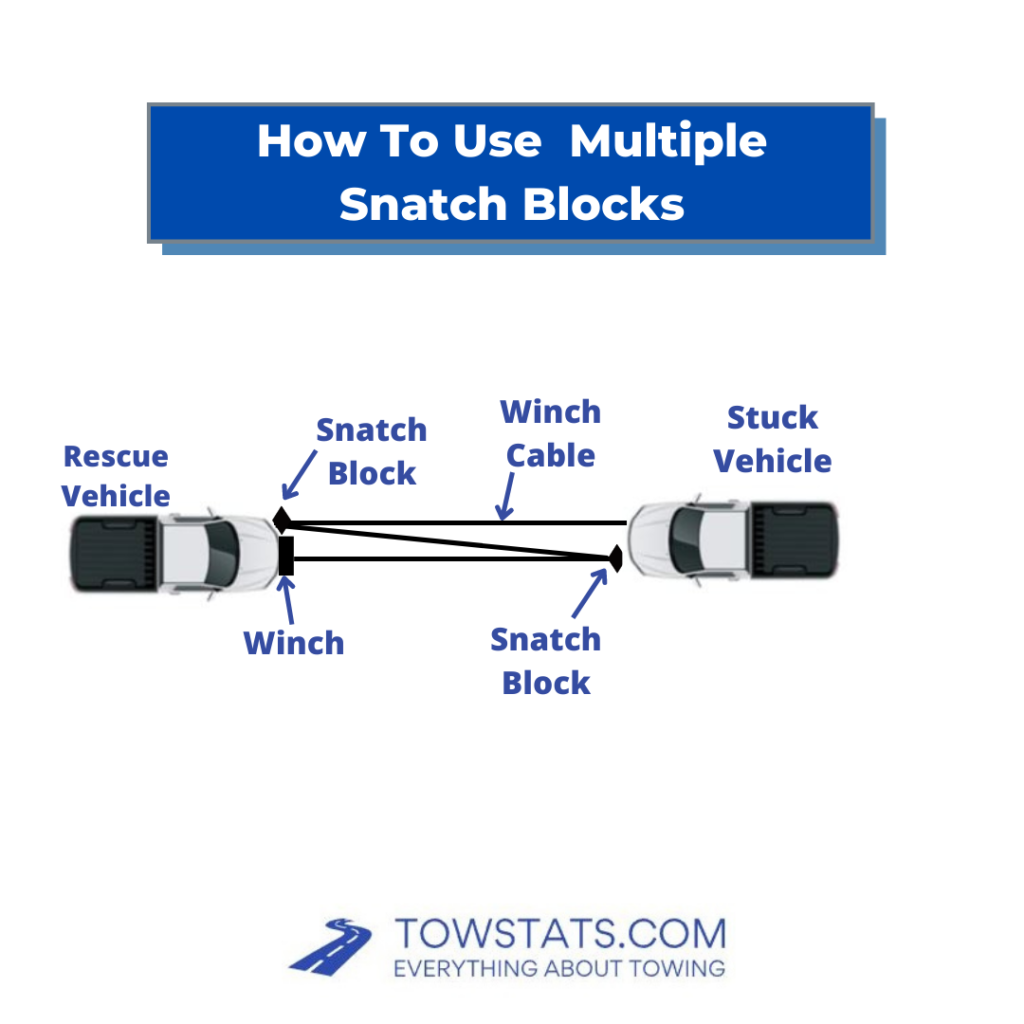Perhaps you’ve come across a snatch block in your towing or off-road experience and are wondering how to use a snatch block. Winching is a common activity for off-road enthusiasts and professionals, and a snatch block can make vehicle recovery much easier.
In this article, we’ll explain what a snatch block is and how to use a snatch block safely and effectively.
What Is A Snatch Block?
A snatch block (aka pulley block) is a heavy-duty pulley that can be used to change the direction of a winch line or rope and increase the pulling force of a winch.
Snatch blocks usually have a metal casing with removable sides plate so that they can be easily attached to a D-ring or other attachment point.

Snatch blocks are pretty simple in their design, consisting of a pulley (or sheave) between two side plates made of metal, and everything’s held together with a pin (called a sheave pin).
You can twist the two side plates away from each other so you can insert the winch line.
The plates have holes on them that allow the snatch block to be attached to different accessories to anchor them.
You can attach snatch blocks to trees, shackles, recovery straps, or other anchor items.
How Does A Snatch Block Work?
So if a snatch block (or pulley block) is just a heavy-duty pulley, how can it increase the mechanical advantage of your winch?
Pulleys don’t increase winch power, so how can a snatch block?
The difference here is that you’re looping the winch cable around the snatch block at the anchor point, then reconnecting it back to your vehicle that the winch is on.
So instead of the winch pulling against a tree, rock, or another vehicle, it’s actually pulling on itself, which increases the power.
Here’s a great video explaining the power of pulleys and snatch blocks, and the differences between them.
Jump to about halfway through the video for some great snatch block footage:
How To Use A Snatch Block
There are many ways to use a snatch block, and we’ll explain how to perform each of these functions.
How To Use A Snatch Block To Increase Winch Pulling Power
The most common use is to increase the pulling power of your winch.
Let’s say you got your vehicle stuck somewhere and there’s no one else around to get you out.
If you have something nearby that can bear the load of your vehicle like a tree, you can pull the cable from your winch, loop the cable around the tree, through the snatch block, and reattach it to your vehicle.

By running your winch line through the snatch block and back to your anchor point, you effectively create two lines, nearly doubling your winching power.
The same rule applies to using a second vehicle as the stable point versus a tree.
You can attach the snatch block to the stuck vehicle and anchor it back to the rescue vehicle, increasing pulling power and saving strain on your winch.

Several snatch blocks can be used in order to get more power out of your winch.
Take a look at the diagram below for an explanation:

It’s important to note that when you use a snatch block like this, you are essentially doubling the force exerted on it.
If you are using a winch line that isn’t rated for that kind of force, you’re going to risk breaking the line, injuring someone, or damaging your vehicle.
How To Use A Snatch Block To Redirect The Winch
Another common use for a snatch block is to change the direction of your pull.
This can be useful if you need to pull your vehicle around a tree or other obstacle, allowing you to pull at different angles.
Take a look at the image below:

As you can see, the tree is providing an anchor point so that the rescue vehicle can pull the other vehicle out, even though it is not directly ahead of it.
This gives you tons of versatility and maneuvering options.
We should note that it does not increase the power of the winch in this example, because the snatch block is not looping back to the winch.
How To Connect A Snatch Block To A Tree Saver
In addition to having a snatch block, you should also keep a tree saver in your towing toolbox.
A tree saver is a strap made from nylon or polyester webbing that helps connect your winch to a tree for recovery purposes.
Follow these steps to connect a snatch block to a tree saver:
- Find a tree that is large enough to handle the load of the vehicle being pulled.
- Loop the tree saver around the tree.
- Use a shackle to connect the snatch block to the tree saver.
- Thread the winch line through the snatch block pulley prior to connecting it to the shackle.
- Connect the ends of the winch line to the stuck vehicle and the rescue vehicle at appropriate points.
- Use the winch slow and steady to pull the stuck vehicle out using the winch and snatch block.
- Make sure to use a shackle with an appropriate working load limit (WLL) that can handle the load to prevent it from breaking and causing damage.
General Snatch Block Safety Tips
A few considerations to keep in mind:
- Always use gear rated for the working load limit you’re pulling (wire rope, snatch blocks, and anchor shackles).
- When considering the working load limit of your gear, keep in mind that every snatch block you add actually adds additional load (if pulling back on the source itself).
- Wear leather gloves
- Don’t use a hook on the end of a cable, only anchor shackles.
- Put a coat, blanket, or line weight on the winch line in case of breakage or kick back.
- Don’t straddle the cable when it’s being used!

